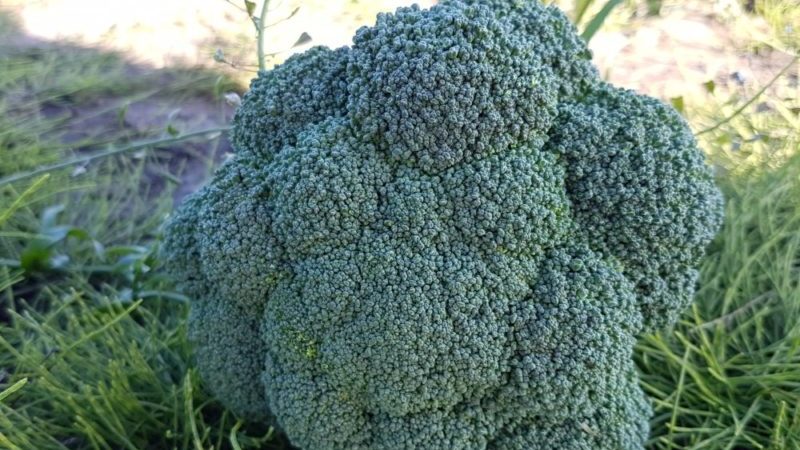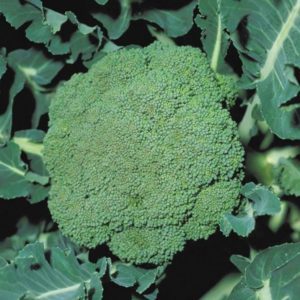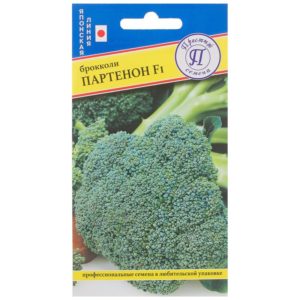High-yielding late ripening hybrid of broccoli cabbage Parthenon f1
Broccoli is an unusual vegetable that has fallen in love with domestic consumers in recent decades. The dense green buds are nutritious, healthy and widely used in dietary nutrition.
The article will tell you about the Parthenon F1 hybrid: about the advantages, features of growing a crop, purpose and application.
The content of the article
- Description of hybrid broccoli cabbage Parthenon F1
- Main advantages and disadvantages
- Features of planting and growing
- Harvesting and storage
- What can be the difficulties in growing
- Tips and Feedback
- Conclusion
Description of hybrid cabbage broccoli Parthenon F1
It is an annual vegetable, a member of the vast and varied Cabbage (Cruciferous) family.
Origin and development
According to historical data, broccoli as a vegetable crop (lit. - shoot, dry twig) was bred by the ancient agronomists of the Eastern Mediterranean in the 5-6th century. BC e.
The vegetable came to Europe in the middle of the 16th century. The British began to call it Italian asparagus in the 18th century. In the 20-30s. last century broccoli began to grow in the USA, Spain, Italy, Russia.
Reference. Broccoli is the progenitor of cauliflower.
Breeding history
The Japanese seed company "Sakata Seed Corporation" is engaged in breeding and distribution valuable varieties vegetable and flower crops from the beginning of the 20th century. Broccoli Parthenon F1 - the result of tests (crossing of parental types) with the aim of breeding the best variety, a product of high quality selection. It is a first generation hybrid patented in many countries.
Distribution agrarian firms distribute it throughout the CIS: Gavrish (Russia), Sakura Ukraine (Ukraine).
Chemical composition, trace elements and vitamins, useful properties

The inflorescences used for food are a dietary product. There are only 34 kcal per 100 g.
This cabbage contains (per 100 g):
- up to 3 g of useful protein;
- 0.5 g fat;
- over 6.5 g of carbohydrates;
- up to 3 g of dietary fiber;
- 88 g of water.
Rich in vitamin composition:
- vitamins A, C, E, K, PP;
- B vitamins: B1, B2, B5, B6, B9 (folic acid).
Minerals (fraction of the daily value):
- 29% calcium;
- 24% iron;
- 33% magnesium;
- 42% phosphorus;
- over 50% potassium.
Broccoli Parthenon F1 contains antioxidants, removes heavy metal salts, poisons, cleanses the intestines, and promotes weight loss.
Important. Protein (protein) in this hybrid is three times more than in asparagus, spinach, corn. In terms of the number of essential amino acids, the vegetable is not inferior to beef. The content of lysine, tryptophan in inflorescences is equal to that of a chicken egg.
It has been proven that sulforaphane resists cancer and viruses. Sinigrin prevents the proliferation of malignant cells. Choline and methionine remove harmful cholesterol, cleanse blood vessels.
Application features
Broccoli Parthenon F1 is used in cooking in fresh and frozen form - added to salads and summer cold soups, vegetable smoothies and cocktails are prepared.
Taste and useful properties are preserved after heat treatment. Variety of delicate fruit dishes:
- boiled broccoli (it is important not to overcook);
- steamed or blanched;
- casseroles, omelettes and vegetable stews;
- fried pieces in batter and breading;
- as a side dish fried and boiled;
- add to vegetable dietary soups and cheese puree soups;
- finely chopped inflorescences are kneaded into muffin dough;
- decorate pizzas and open vegetable pies.
Ripening period
Average ripening period - up to three months (90-95 days) from the date of disembarkation seedlings into open ground. Under optimal conditions of soil, lighting, climatic zone, humidity.
Yield
The late-ripening variety gives a high yield. Average indicators - 3-3.5 kg per 1 sq. m.
On large areas, 12-18 tons per hectare are harvested per season.
Disease and pest resistance
Parthenon F1 has inherited resistance to viruses and infections from genetic "parents". It painlessly tolerates daily temperature drops, lack of water and high humidity from seasonal precipitation.
Cold resistance
Broccoli Parthenon F1 is cold-resistant, adapted to harsh climatic conditions. Withstands even small frosts.
Characteristics, description of appearance, taste
The plant develops into a spreading bush. The leaves are large, bluish in color, juicy even in the absence of abundant watering. The leaf plate is vesicular, the edges are wavy. There are no covering leaves. Lateral shoots are rare.
The root is powerful, provides nutrition and fluid storage.
The stalk is thick, it grows up to 50 cm in height. Succulent peduncle branches form at the top, forming groups of small buds. The buds are collected in a compact fruit head. "Beads" are homogeneous, small.
The inflorescence head is bright green, dense, rounded, has a solid mushroom shape. The weight of the matured head is 0.5-1 kg. Under favorable conditions, it grows up to 1.5 kg.
For which regions it is best suited and what is the exacting climate
Agronomists recommend planting early spring (EOS, Ironman) and autumn (Parthenon, Triton, Batavia) broccoli varieties in the southern regions.
Parthenon is also planted in areas of the central, middle strip. The only condition is that sowing is carried out 7-10 days later.
Main advantages and disadvantages
The hybrid has advantages and differences:
- Seed material has quality certificates confirming compliance with international standards and GOST of the country of the distributor.

- Due to its structure, excess moisture does not accumulate on the surface of the head - condensation after rain (harmful infections and rot viruses do not penetrate).
- Head density is higher than other varieties (eg Competitor). This property gives more weight and better commercial quality during storage.
- The compact fruit can be easily disassembled into whole branches (convenient for processing and freezing).
- The fruits do not contain GMOs, harmless to people of any age.
- With long-term storage, it does not lose its taste, the color remains even after defrosting.
The disadvantages include:
- Seed material is expensive. For its production, special conditions are required (protected soil, long-term selection, crossing of certain parental varieties). However, these seeds give 100% of the yield, so that the money spent pays off in the output.
- Harvesting seeds at home will not work. In the second generation, the positive characteristics of the hybrid and the quality of the crop are not preserved. The "offspring" degenerates, heterogeneous inflorescences ripen. Taste and keeping quality are low.
Features of planting and growing
Grow hybrid Parthenon in two ways:
- through ready-made seedlings;
- sowing seeds in open ground (long process of fruit ripening).
Preparing for landing
It is important to choose an open place on the site - the plant needs a lot of light and moisture. The site is prepared in the fall - when digging, organic fertilizers (manure, compost) or superphosphate, saltpeter are applied.Sour soil is limestone - limestone, dolomite or slaked lime is added.
It is recommended to plant seedlings after carrots, legumes and nightshades. It is undesirable to choose a site after cultivation plant relatives of the Cabbage family.
Ground requirements
Broccoli Parthenon prefers loose, fertile soil. The optimum acidity level is low or medium.
Timing, scheme and landing rules
The time for sowing seeds depends on the climate:
- In a warm climatic zone, they are sown in early or mid-March.
- In the central and northern regions, planting dates are shifted by 1-2 weeks - to the end of March - beginning of April.
- Seedlings are planted in open ground after 30-35 days from the moment of seed germination. Period: early to mid-May.
Planting scheme in open ground:
- the distance between the holes is 30-40 cm;
- the distance between the rows is 50-60 cm.
Care rules:
- the pick is carried out during the formation of the cotyledons;
- regular weeding is required;
- water the seedlings every other day under the root, in the early morning or after sunset.
The seedlings are supported and nourished during the entire ripening period in stages:
- a week after planting the seedlings, a weak solution of cow or bird droppings is introduced through watering;
- the second organic feeding after 10-15 days;
- after the formation of inflorescences, organic matter is mixed with superphosphate, calcium sulfate, ammonium nitrate;
- after cutting, to stimulate the growth of repeated lateral shoots, it is recommended to fertilize the soil with potassium sulfate, superphosphate or nitrate.
It is important to observe the dosage, taking into account the type of soil and the varietal characteristics of the crop (instructions are attached to each preparation).
Growing features
The optimum temperature for development and growth is 16-24 ° C.
In the heat, abundant regular watering is required twice a day - in the morning and in the evening.
Tips from summer residents:
- from gusts of wind and the burning spring sun, young seedlings will be saved by a temporary shelter - they use thermally bonded spunbond or other agrofibre;
- on the garden plot, adult bushes protect against gusts of wind by tying them up (pegs are driven in next to them);
- to fertilize early seedlings, it is recommended to use a mixture of nettle tincture and chicken droppings;
- feeding is repeated after 2-3 weeks;
- in June-July, it is advisable to feed the bushes with humate or potassium sulfate.
The nuances of care
If the soil has not been fertilized since autumn, it is required to apply top dressing directly during planting:
- it is recommended to put a little mixture of compost and wood ash in each hole;
- with increased acidity of the soil, dolomite flour is added to the hole (lime can harm young shoots).
Disease and pest control
After radishes, turnips and radish broccoli, Parthenon is contraindicated to plant - they have the same pathogens and infections.
Dangerous diseases:
- powdery mildew;
- mosaic spotting;
- bacterial rot;
- blackleg.
After sowing, the soil is treated with "Butizan", "Fuzilat". To protect seedlings, "Trichocin", "Planra" are introduced into the soil. The drug "Vitaplan" has proven itself well.
Common pests:
- slugs and caterpillars destroy greenery;
- whitefly, aphids, bugs and fleas feed on plant sap;
- bears and cabbage flies destroy the root system.
Treatment with pesticides (Fitoverm) is recommended. The solution, according to the instructions, is used to treat the aboveground part, compost and soil.
From flies, bugs and flea beetles, drugs "Intavir" or "Actellik" will save. For prevention, the soil and seedlings are sprayed with a solution of Bordeaux liquid.
Harvesting and storage
Harvesting times vary by region. It is important to have time to harvest before flowering. The inflorescences are cut in late summer or early September in cool, dry weather.
Storage features
Hybrid Parthenon F1 is the sales leader. Suitable for short-term fresh storage. Perfectly retains its taste and useful qualities in a frozen state.
What can be the difficulties in growing
Broccoli prefers open, well-lit areas, but the vegetable does not tolerate heat. Required soil moisture - up to 75%, air - at least 85%. For a full harvest, regular irrigation and watering is required.
Attention! At high temperatures (more than + 25 ° C) and long daylight hours, loose, small inflorescences ripen.
On poor, dense loams, development and maturation are problematic. Fertilizing, draining and loosening the soil are prerequisites for growing.
Tips and Feedback
On summer cottage forums and blogs, experienced vegetable growers and gardeners leave comments about broccoli varieties, highlighting Parthenon as one of the best.
Natalia, Moscow region: “I always made Linda and Macho sit down. This spring, at fear and risk, I tried the novelty Parthenon. And I was not mistaken, the yield, even in our climate, pleased and surprised ”.
Olga, Tver: “Broccoli Parthenon is my favorite, wonderful and healthy cabbage. Protect it from the heat, and, I assure you, you will not be left without a crop, I advise everyone to plant and try. "
Conclusion
Broccoli Parthenon F1 - universal hybrid, easy to grow, not exposed to climatic stress. A useful dietary product - with a low calorie content, it contains a lot of protein and well-absorbed carbohydrates. During storage (freezing) and heat treatment, it retains its beneficial properties by 80%.